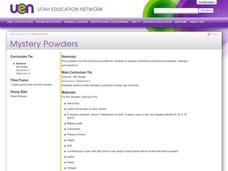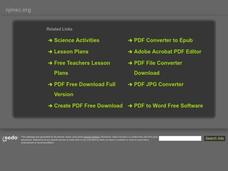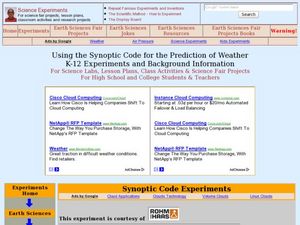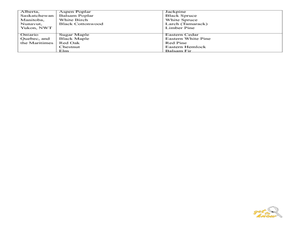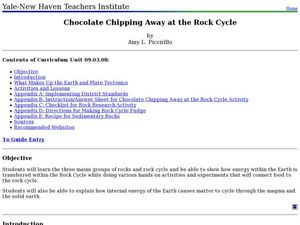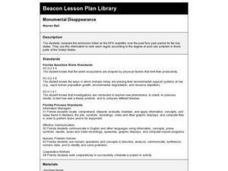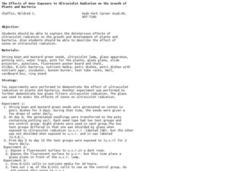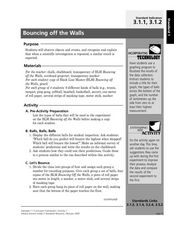Curated OER
Mystery Powders
Fifth graders evaluate the physical properties of 5 powders. Each powder is subject to different conditions. They describe each observation as with a chemical change or a physical change.
Curated OER
Cold Front Characteristics
Students study weather characteristics of a cold front passage. They view animations of several atmospheric variables (e.g., temperature, rainfall) during a cold front passage and locate the front, determine its direction of movement,...
Curated OER
Rocks on Parade!
Third graders describe and classify rock samples. In this rock lesson, 3rd graders make inferences about rock samples by observing and measuring them. This lesson contains 5 different stations for the students to go to.
Curated OER
Classification and Identification
Students, after exploring and analyzing diagrammatic and taxonomic keys and their association to marine sciences, identify and classify objects and organisms based on visual attributes/characteristics. They research and create their own...
Curated OER
Properties of Minerals
Young scholars research properties of minerals. In this science lesson, students search the web, create a folder, and store information on properties of minerals. There are many excellent worksheets and study guides embedded in this...
Curated OER
Volcanic IntEruptions
Seventh graders research about a devastating eruption of a certain volcano. In this earth science lesson plan, 7th graders discover the climate changes that occurred due to a volcanic eruption. They create a presentation about their...
Curated OER
Using the Synoptic Code for the Prediction of Water
Students construct a thermoscreen for the experiment. For this earth science lesson, students make observations and interpret them using synoptic codes. They predict the weather based on gathered information.
Curated OER
What's Inside
Students become more familiar with life science in the context of the scientific method which helps them to become familiar with the various kinds of life science diagrams they may see on a GED science test.
Curated OER
Light and Optics
Third graders utilize the scientific method to explain light and optics in this five lessons unit. Through experimentation and discussion, 3rd graders canvass the concepts of light traveling, reflection and refraction.
Curated OER
Watershed Lesson Plan
Students are introduced to the concepts of a watershed, stream flow and water quality. This five-day plan is an excellent way to introduce students to the concepts involved. They create their own watershed using a paper bag, water and...
Curated OER
Get to Know Trees
Students recognize the characteristics of trees by using their five senses. In this trees lesson, students observe and record the characteristics of trees on a field trip. Students then are blindfolded and use their senses to identify...
Curated OER
The Weather
Students explore earth science by reading articles in class. In this weather identification lesson, students analyze weather science articles on the Internet and view their own local weather patterns as well. Students define a list of...
Curated OER
Chocolate Chipping Away at the Rock Cycle
Eighth graders identify the different types of rocks. In this earth science lesson, 8th graders compare and contrast rocks and chocolate cookies. They explain how materials are recycled beneath the Earth.
Curated OER
What Did I Touch Today?
Students investigate germs and how they travel. They graph the places in the classroom that have been touch by students to determine which five places have had the most contact. They write stories from a germ's point of view.
Curated OER
Monumental Disappearance
Fourth graders compare the emissions listed on the EPA isopleths over the past five-year period for ten key states. They use this information to rank each region according to the degree of acid rain problem in those parts of the United...
Curated OER
Animal Classification
Third graders differentiate between vertebrates and invertebrates, and identify the main characteristics of mammals, fish, reptiles, amphibians, and birds. They sort and categorize different types of balls, discuss the characteristics...
Curated OER
This Can't be a Plant
Learners grow mold. In this science experiment lesson, students grow mold on different pieces of bread by adjusting the moisture, temperature, and light. They record the results to see which grows the most mold.
Curated OER
Pasta Bridges
Learners analyze the correct use of technology as it relates to math and science. In this science lesson, students investigate force and weight as it relates to building an object. They build a bridge and draw conclusion based on the...
Curated OER
Surviving the Conditions
Students explore Earth science by participating in an environmental care activity. In this natural resources lesson, students discuss ways to protect themselves from the environment if they are ever in need of shelter in the wilderness....
Curated OER
Summer
Students discover different uses of water. They discuss what lives in water and what does not. They match numbers 1-5 with objects of correct amount and recognize 5 different colors. They pick from pictures of different ways water...
Curated OER
The Effects of Over Exposure to Ultraviolet Radiation on the Growth of Plants and Bacteria
Students investigate the effects of UV light and ozone on plant and bacteria growth. In this ultraviolet light and ozone lesson plan, students grow bean and mustard greens to study the effects of UV light and ozone on the plant growth....
Curated OER
Round and Round-The Water Cycle
Students explore the water cycle. In this earth science activity, students work in small groups to read various books on the water cycle and take notes on chart paper. Students share their notes and teach a younger audience what they...
Curated OER
Bouncing off the Walls
Third graders compare the bouncing height of different types of balls. In this science lesson, 3rd graders explain the importance of repeated experimentation in science. They record their result and share them with the class.
Curated OER
Parental Genes
Eighth graders explore how different organisms pass their traits to their offspring. In this life science lesson, 8th graders differentiate recessive and dominant alleles. They predict the phenotype based on the genotype of an organism.
Other popular searches
- 5 E Science Magnets
- 5 E Science Lessons
- 5 E Science Forces
- Science 5 E Model
- Science 5 E
- Life Science 5 E
- Science 5 E Model
- 5 E Science Lesson Plans
- 5 E Model Science Lessons
- Physical Science 5 E
- 5 E Science Flowers
